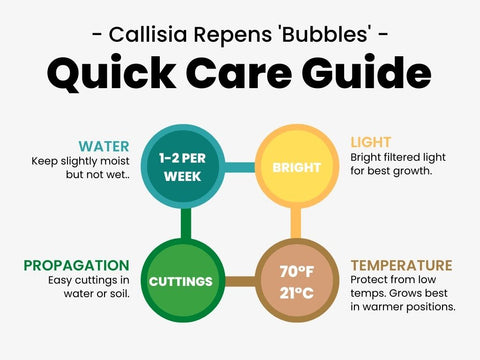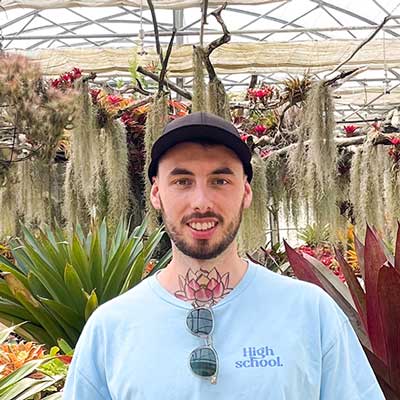Introduction
Callisia bubbles is a small creeping succulent plant originally from Central and South America. It has small green leaves on the top and from underneath a dark purple colour. It has a compact but creeping growth. Great for hanging baskets or on shelves or window sills. It can be left hanging or trimmed regularly to keep a more compact appearance.
General Care
Callisia bubbles is a very easy to care for, low maintenance plant. It can grow very rapidly and in a variety of conditions and hence is a great beginner plant. A moderate amount of light, water and in good soil will keep this plant happy.

1. Light -
Callisia prefers more sunlight than a lot of other indoor plants however, it can grow in low light areas too. Bright indirect sunlight will make the plant grow faster and have more colour. Some direct light can also be beneficial. Too much light and the leaves will burn and turn brown. Not enough light and the growth will become pale and elongated. Also, the variegated Pink Bubbles Plant requires more light than the standard variety to maintain it's colours - which you can get using LED plant grow lights.
2. Temperature -
Callisia can grow in a variety of temperatures although a moderate temperature is best. Callisia can even be grown outdoors in a sheltered or shady position but protect from frost in cold areas. For fastest growth, a warm and humid environment such as a bathroom is ideal.
3. Humidity -
Although Callisia loves a warm, wet, humid environment it doesn’t actually require higher humidity to grow well. Misting your plant or increasing the humidity occasionally could be beneficial but not necessary as long as the watering is done correctly, standard home humidity will be fine for bubbles. One way to create humidity is by watering your plant in the shower and wetting the stems, leaves and soil at the same time.
4. Water -
Callisia bubbles grows well with the soil slightly moist but make sure it is not sitting in water or it can rot. Water once per week, less often in Winter and more often in Summer. Because it is a succulent, it can go for long periods without water however, this is not ideal - without enough water the leaves with shrivel and start to brown. Whereas, if there is too much water the stems and roots with rot and kill the plant. Underwatering is better than overwatering.
5. Soil -
Callisia is quite versatile in terms of soil mix however a well-draining and aerated soil is very important for the health of the plant. You can either buy pre-made bags of soil or make your own mix with things such as potting mix, sphagnum moss and perlite.
6. Repotting -
Because Bubbles can grow relatively quickly, you may need to repot it every now and again. If required, plant into a larger pot with fresh soil and water it well. Repotting is a great time to add some slow-release fertiliser too.
7. Fertiliser -
Regular fertiliser keeps the leaves, roots, and growth healthy and colourful. It is recommended to fertilise every month depending on the growth rate. Small plants in smaller pots don’t need as much fertiliser, same as in Winter when growth is lower. A combination of liquid and slow-release fertiliser will ensure a strong beautiful plant.
8. Maintenance -
Because of its rapid growth rate you will probably need to prune your plant at some point of which the cuttings can be used for propagation. Trim off any dead leaves or long stems to create the shape you want. Prune the stems right back if you prefer a dense bush or leave them to grow out if they are hanging such as in a basket or on a shelf.
Propagation
Callisia bubbles is very easy plant to propagate. Its ability to propagate quickly. There are two methods for propagation which are both extremely easy and usually have very high success rates.
9. Cuttings in soil -
Simply take a healthy stem cutting from your plant about 5-10cm in length and place them into fresh soil. Keep the soil moist and add a cover over the top to create a humid environment.
10. Cuttings in water -
This is the easiest way to propagate Callisia: simply place cuttings in a jar of clean water or in propagation stations and leave in a warm bright area. Keep the water topped up and change for fresh water each week. Roots will grow quickly and can be transferred to soil once they are big enough. This is sometimes a preferred method for some as you can see the root progress.



